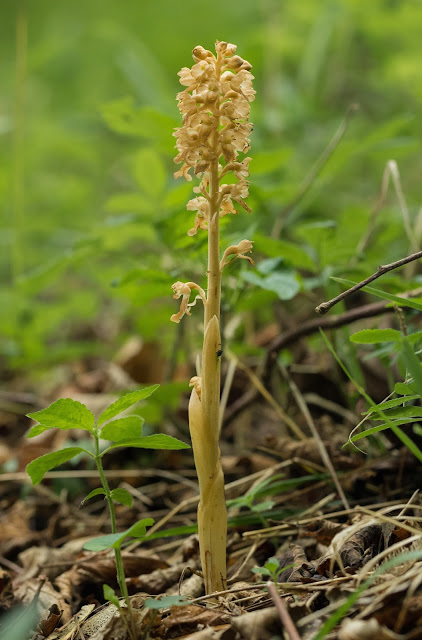Having last seen Bird’s-nest Orchids once before way back in 2010, I was keen to catch up with several plants in bloom on the Great Orme in Llandudno, handily just over an hour away from home. Not being able to get over there to see them last year, late May saw us take a trip over to this botanically rich hotspot to explore the woodlands around the base of the Orme in an effort to try and find them.
Parking up at the Happy Valley car park area and taking one of the small trails into the trees, expecting a lengthy search I was surprised at just how quickly we stumbled across our orchids – looking up the slope we were met with two distinctive caramel-brown flower spikes nestled among the Dog’s Mercury and looming out of the dark understorey gloom.
Parking up at the Happy Valley car park area and taking one of the small trails into the trees, expecting a lengthy search I was surprised at just how quickly we stumbled across our orchids – looking up the slope we were met with two distinctive caramel-brown flower spikes nestled among the Dog’s Mercury and looming out of the dark understorey gloom.
At first glance perhaps appearing dead to the untrained eye, on closer inspection they were flowering to perfection, tiny golden florets adorning tall leafless stems in the deep shade of the woodland floor.
A quick exploration of the surrounding area also revealed a third spike hidden a little bit further up into the trees, but we were unable to spot any additional plants in the immediate vicinity. With just three spikes (there were apparently only three plants last year too) this looks to be a very small population, but with extensive woodland carrying on further up the slope it’s highly likely there could well be more in the area.
Although Bird’s-nest Orchids can often be perceived as drab, uninteresting and plain looking due to their uniform brown flowers and stems (especially compared to some of the other more extravagant orchid species), there is actually a subtle beauty to these unusual orchids, with each petal looking as if it has been brushed with a delicious coating of sticky golden honey and almost looking good enough to eat.
 |
| The Bird’s-nest Orchid has a tangled mass of roots, shaped, unsurprisingly, like a bird’s nest and indicating how it gets its name |
Looking back at the historical records it seems Bird’s-nest Orchid was present on the Great Orme back in the 1970’s and up to 1986, but a lack of reports after this time indicates they may have disappeared at the site until recently (I’m aware they’ve been occurring here for the past three years though at least).
 |
| Bird's nest Orchid photography in action! |






No comments:
Post a Comment